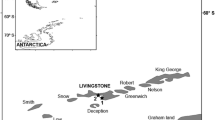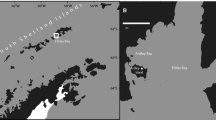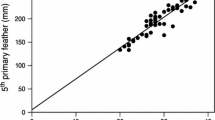Abstract
We performed stable carbon (δ13C) and nitrogen (δ15N) isotope analyses of 12 ancient Adélie penguin (Pygoscelis adeliae) chick mummies recovered from abandoned colonies in the Ross Sea region, Antarctica, to investigate isotopic variation and fractionation over time. We also examined latitudinal variation in penguin diet to address if the modern dietary pattern (an increase in krill as dominant prey to the north) in this region has existed in the past or if this is a recent phenomenon. The ancient mummies range in age from > 48,000 14C years before present (BP) to ~ 500 calendar years BP. Feather, skin, bone, and toenail samples were analyzed from each individual where available. Identical analyses were performed on five modern mummified Adélie penguin chick carcasses and breast feathers of ten recently dead chicks from each of two active colonies, Cape Hallett and Adélie Cove. We found significantly lower δ15N values in Cape Hallett modern chicks as compared to those from Adélie Cove, indicating an entire trophic-level difference in modern diet that agrees with other studies in this region. The ancient mummies exhibited consistent isotopic fractionation of δ13C among the four different tissues through time. Variation in δ15N and δ13C values was greater in bone and skin than in feather or toenail, but δ15N in all four tissues indicated similar dietary trends with latitude as occurs in this region today. These results provide insight into the dietary variability of Adélie penguins across the Ross Sea region and a framework for similar analyses with other avian species.





Similar content being viewed by others
Data availability
Raw data from stable isotope analyses are available as supplemental information. Any additional data that support the findings of this study are available from the corresponding author, Allyson K. Kristan, on request.
References
Ainley DG (2002) The Adélie Penguin. Columbia University Press, New York
Ainley DG, Wilson PR, Barton KJ, Ballard G, Nur N, Karl B (1998) Diet and foraging effort of Adélie penguins in relation to pack-ice conditions in the southern Ross Sea. Polar Biol 20:311–319
Baroni C, Orombelli G (1994) Abandoned penguin rookeries as Holocene paleoclimatic indicators in Antarctica. Geology 22:23–26
Bond AL, Jones IL (2009) A practical introduction to stable-isotope analysis for seabird biologists: approaches, cautions and caveats. Mar Ornithol 37:183–188
Brettell R, Martin W, Atherton-Woolham S, Stern B, McKnight L (2017) Organic residue analysis of Egyptian votive mummies and their research potential. Stud Conserv 62:68–82
DeNiro MJ, Epstein S (1978) Influence of diet on the distribution of carbon isotopes in animals. Geochim Cosmochim Acta 42:495–506
Dinniman MS, Klinck JM, Smith WO Jr (2011) A model study of circumpolar deep water on the West Antarctic Peninsula and Ross Sea continental shelves. Deep Sea research Part II 58:1508–1523
Emslie SD, McDaniel JD (2002) Adélie penguin diet and climate change during the middle to late Holocene in northern Marguerite Bay, Antarctic Peninsula. Polar Biol 25:222–229
Emslie SD, Berkman PA, Ainley DG, Coats L, Polito M (2003) Late-Holocene initiation of ice-free ecosystems in the southern Ross Sea, Antarctica. Mar Ecol Prog Ser 262:19–25
Emslie SD, Coats L, Licht K (2007) A 45,000 yr record of Adélie penguins and climate change in the Ross Sea, Antarctica. Geolgy 35:61–64
Emslie SD, Polito MJ, Brasso R, Patterson WP, Sun L (2014) Ornithogenic soils and the paleoecology of pygoscelid penguins in Antarctica. Quat Int 352:4–15
Emslie SD, McKenzie A, Patterson WP (2018) The rise and fall of an ancient Adélie Penguin ‘supercolony’ at Cape Adare Antarctica. R Soc Open Sci 5:172032
Erikstad KE (1990) Winter diets of four seabird species in the Barents Sea after a crash in the capelin stock. Pol Biol 10:619–627
Frazer TK (1996) Stable isotope composition (δ13C and δ15N) of larval krill, Euphausia superba, and two of its potential food sources in winter. J Plankton Res 18:1413–1426
Frazer TK, Ross RM, Quetin LB, Montoya JP (1997) Turnover of carbon and nitrogen during growth of larval krill, Euphausia superba Dana: a stable isotope approach. J Exp Mar Biol Ecol 212:259–275
Hilton GM, Thompson DR, Sagar PM, Cuthbert RJ, Cherel Y, Bury SJ (2006) A stable isotopic investigation into the causes of decline in a sub-Antarctic predator, the rockhopper penguin Eudyptes chrysocome. Glob Change Biol 12:611–625
Hobson KA (1993) Trophic relationships among high Arctic seabirds: insights from tissue-dependent stable-isotope models. Mar Ecol Prog Ser 95:7–18
Hobson KA, Clark RG (1992) Assessing avian diets using stable isotopes I: turnover of 13C in tissues. Condor 94:181–188
Hobson KA, Welch HE (1992) Determination of trophic relationships within a high arctic marine food web using δ13C and δ15 N analysis. Mar Ecol Prog Ser 84:9–18
Hobson KA, Alisauskas RT, Clark RG (1993) Stable-nitrogen-isotope enrichment in avian tissues due to fasting and nutritional stress: implications for isotopic analysis of diet. Condor 95:388–394
Hobson KA, Piatt JF, Pitocchelli J (1994) Using stable isotopes to determine seabird trophic relationships. J Anim Ecol 63:786–798
Hofstee EH, Balks MR, Petchey F, Campbell DI (2006) Soils of Seabee Hook, Cape Hallett, northern Victoria Land, Antarctica. Antarct Sci 18:473–486
Hunt GL Jr, Eppley ZA, Schneider DC (1986) Reproductive performance of seabirds: the importance of population and colony size. Auk 103:306–317
Kelly JF (2000) Stable isotopes of carbon and nitrogen in the study of avian and mammalian trophic ecology. Can J Zool 78:1–27
Lambert DM, Ritchie PA, Millar CD, Holland B, Drummond AJ, Baroni C (2002) Rates of evolution in ancient DNA from Adélie penguins. Science 295:2270–2273
Louanchi F, Hoppema M (2000) Interannual variations of the Antarctic Ocean CO2 uptake from 1986–1994. Mar Chem 72:103–114
Lyver P, Barron M, Barton KJ, Ainley DG, Pollard A, Gordon S, McNeill S, Ballard G, Wilson PR (2014) Trends in the breeding population of Adélie Penguins in the Ross Sea, 1981–2012: a coincidence of climate and resource extraction effects. PLoS ONE 9:e91188. https://doi.org/10.1371/journal.pone.0091188
Minagawa M, Wada E (1984) Stepwise enrichment of 15 N along food chains: further evidence and the relation between δ15N and animal age. Geochim Cosmochim Acta 48:1135–1140
Peterson BJ, Fry B (1987) Stable isotopes in ecosystem studies. Ann Rev Ecol Syst 18:293–320
Polito M, Emslie SD, Walker W (2002) A 1000-year record of Adélie penguin diets in the southern Ross Sea. Antarct Sci 14:327–332
Quay P, Sonnerup R, Westby T, Stutsman J, McNichol A (2003) Changes in the 13C/12C of dissolved inorganic carbon in the ocean as a tracer of anthropogenic CO2 uptake. Glob Biogeochem Cycles 17:1–4
Rau GH, Mearns AJ, Young DR, Olson RJ, Schafer HA, Kaplan IR (1983) Animal C/C correlates with trophic level in pelagic food webs. Ecology 64:1314–1318
Schmidt K, Atkinson A, Stübing D, McClelland JW, Montoya JP, Voss M (2003) Trophic relationships among Southern Ocean copepods and krill: some uses and limitations of a stable isotope approach. Limnol Oceanogr 48:277–289
Schmidt K, McClelland JW, Mente E, Montoya JP, Atkinson A, Voss M (2004) Trophic-level interpretation based on δ15N values: implications of tissue-specific fractionation and amino acid composition. Mar Ecol Prog Ser 266:43–58
Schoeninger MJ, DeNiro MJ (1984) Nitrogen and carbon isotopic composition of bone collagen from marine and terrestrial animals. Geochim Cosmochim Acta 48:625–639
Shepherd LD, Millar CD, Ballard G, Ainley DG, Wilson PR, Haynes GD, Baroni C, Lambert DM (2005) Microevolution and mega-icebergs in the Antarctic. Proc Natl Acad Sci USA 102:16717–16722
Steele KW, Daniel RM (1978) Fractionation of nitrogen isotopes by animals: a further complication to the use of variations in the natural abundance of 15N for tracer studies. J Agric Sci 90:7–9
Stuiver M, Reimer PJ, Reimer RW (2019) CALIB 7.1 [WWW program] at http://calib.org
Wada E, Terazaki M, Kabaya Y, Nemoto T (1987) 15N and 13C abundances in the Antarctic Ocean with emphasis on the biogeochemical structure of the food web. Deep Sea Res Part A 34:829–841
Yang L, Sun L, Emslie SD, Xie Z, Huang T, Gao Y, Yang W, Chu Z, Wang Y (2018) Oceanographic mechanisms and penguin population increases during the Little Ice Age in the southern Ross Sea, Antarctica. Earth Planet Sci Lett 481:136–142
Younger J, Emmerson L, Miller K (2015) The influence of historical climate changes on Southern Ocean marine predator populations: a comparative analysis. Glob Change Biol 22:474–493
Acknowledgements
This research was funded by National Science Foundation Grant ANT-1443585. We thank Kim Duernberger for her assistance and expertise with the mass spectrometer, Sandra Timsic for laboratory analysis at the Saskatchewan Isotope Lab, and Renee Pelletier for producing the map in Fig. 1. We also thank Z. Long and C. Lane for helpful comments on this paper. J. Wood and three anonymous reviewers provided many useful comments that improved this manuscript.
Funding
This research was funded by National Science Foundation Grant ANT-1443585 awarded to S. D. Emslie. A Travel Grant was provided to A. Kristan by the University of North Carolina Wilmington’s Center for the Support of Undergraduate Research and Fellowships (UNCW CSURF) to present a poster of preliminary findings at the 9th International Penguin Congress.
Author information
Authors and Affiliations
Corresponding author
Ethics declarations
Conflict of interest
There are no conflicts of interest by the authors for this research.
Additional information
Publisher's Note
Springer Nature remains neutral with regard to jurisdictional claims in published maps and institutional affiliations.
Electronic supplementary material
Below is the link to the electronic supplementary material.
300_2019_2513_MOESM1_ESM.xlsx
Supplementary file1 (XLSX 10 kb) Raw data table displaying measured δ13C and δ15N values for all tissues sampled in this study
Rights and permissions
About this article
Cite this article
Kristan, A.K., Emslie, S.D. & Patterson, W.P. Stable isotope analyses of ancient and modern Adélie Penguin (Pygoscelis adeliae) mummies from the Ross Sea Region, Antarctica. Polar Biol 42, 1183–1192 (2019). https://doi.org/10.1007/s00300-019-02513-4
Received:
Revised:
Accepted:
Published:
Issue Date:
DOI: https://doi.org/10.1007/s00300-019-02513-4




